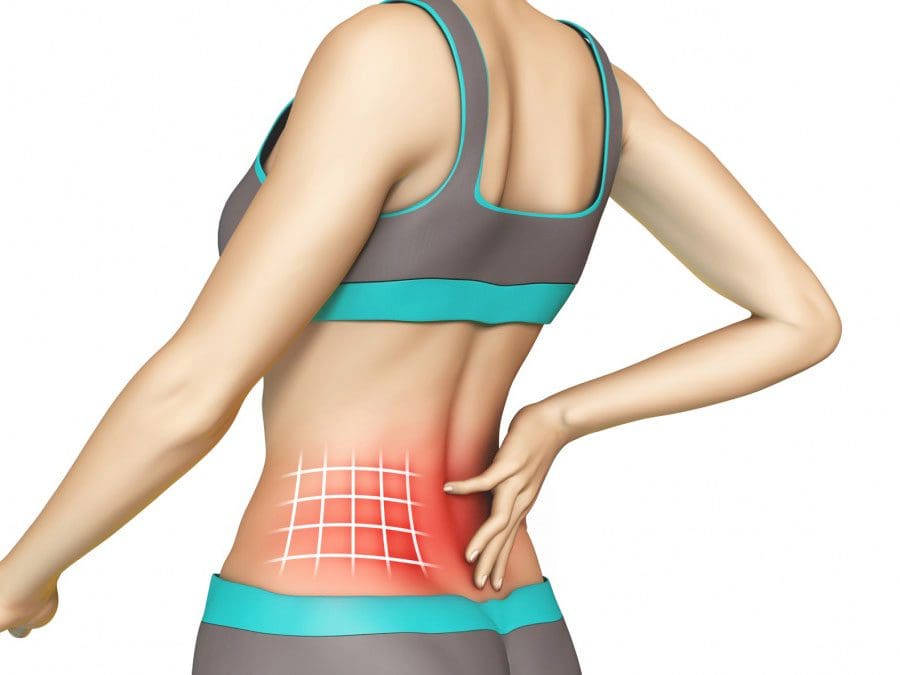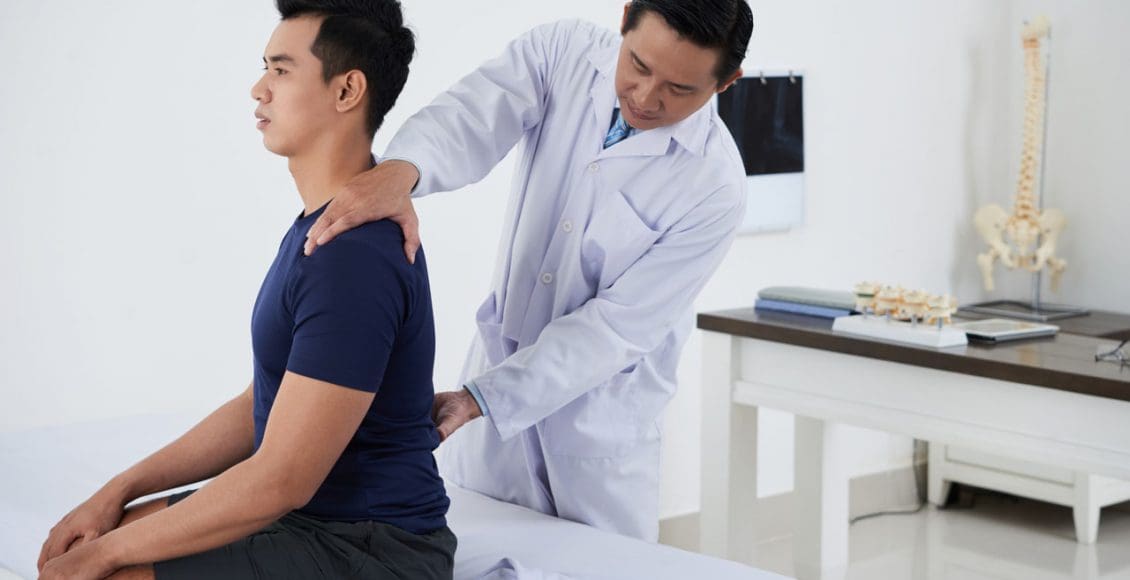Back and low back pain can strike without warning.
It can come from bending over or lifting something and then you’re stuck, unable to move.
However, muscle spasm in the low back is a common occurrence.
Eight out of 10 adults will experience back spasm along with back pain during their lives.

The cause of back pain and spasm can come from:
- Overuse
- Accident
- Sports injury
But a lot of times the root cause of the muscle spasm can come from a tiny injury to one of the structures in or around the lumbar spine.
If there have been one or more episodes of muscle spasm, more than likely it’s going to happen again.
The muscles in the low back all work together with the abdominal muscles.
If they weren’t there, then extension and lateral movement of the spine would be impossible.
The back muscles provide stability and keep the spine erect and balanced.
The balance can be compromised when spasms present along with an injured lumbar joint or disc.
Table of Contents
Muscle spasms
These muscle spasms are involuntary and are contractions that happen spontaneously.
When the spasms occur out of the blue, the triggers are preceded by a series of small strains to the spine which develops over time.
Once the injury is active the inflammation sets in.
Then the nerves become overly-sensitive which causes the muscle/s to contract and spasm.
Disc Disorders & Spasms
Degenerative disc disease or a herniated disc can cause episodes of low back pain.
A herniated or bulging disc can compress a spinal nerve root, which causes irritation and inflammation.
The body tries to control the affected area by tightening the surrounding muscles and that’s when the spasms happen.
Muscles can become too tight because of:
- Lack of exercise
- Too much exercise
- Structural imbalances
- Dehydration
- Electrolyte loss
- Combination of all above
Conversely, there can be muscle groups that have become too weak.
Imbalances present themselves and chronic force is transmitted to the spine in a bad way.
Even a single off movement can trigger an injury to a:
- Spinal joint
- Ligament
- Disc
And this results in spasm and back pain.
Muscle spasm in the low back can be very painful and debilitating over a short period.
Treatment
When it starts:
- For the first 48 to 72 hours apply ice for 20 minutes and then every two hours while on your back.
- Always use an ice pack and never apply directly to the skin.
- After 72 hours then apply moist heat, which can be done with a heating pad.
If this does not work, try soaking in the hot tub, with Epsom salt.
Heat increases blood flow to:
- The affected area
- Relaxes tight muscles
- Relaxes irritated nerves
Also elevating the legs takes the pressure off the spine and can help relieve pain.
Over the counter medications like Aspirin or ibuprofen can help reduce inflammation and pain.
Discuss with physician or healthcare provider regarding dosing regimen most suitable.
There can also be a combination of therapies
- Rest
- Ice/heat
- Medication
- Chiropractic
- Massage
- Physical therapy
- Foot Orthotics
A combination of treatments often generates better results than only one therapy.
Prevention
Once the spasm has passed, and the inflammation has subsided focus on prevention:
- Stretch – Incorporate stretching exercises daily, muscles benefit from gentle stretching.
- Pilates or yoga can work wonders and always stretch before physical exercise.
- Get fit – no regular physical activity can lead to serious conditions and possibly chronic pain.
- Exercise benefits all, even some light walking around the neighborhood is enough. Just get moving!
- Playing a sport could be a way to keep active. Remember, in order for any exercise to work is that it is done regularly.
- Strength training is important, just as its name implies strength training builds muscle and reduces muscle imbalances.
It’s never too late to increase strength and flexibility.
Look at activities that you and your friends/family can enjoy and make doing them a regular thing.
A chiropractor is the ideal medical professional to consult with for any unexplained pain in the musculoskeletal system. They are highly qualified professionals that their specialty is treating conditions like lower back pain and they are very affordable. If you or a loved one have pain in the lower back, give us a call. We’re here to help!
Understanding Foot Pronation & Correcting it with *FootLevelers Orthotics*| El Paso, TX (2019)
Foot pronation is the natural movement that occurs during foot landing while walking or running. Foot pronation also occurs while standing, and in this instance, it is the amount in which the foot rolls inward toward the arch. Foot pronation is normal, however, excessive foot pronation can cause a variety of health issues, including bad posture. The following video describes the 5 red flags of excessive foot pronation, which can ultimately affect a person’s overall health and wellness. Dr. Alex Jimenez can help diagnose and treat excessive foot pronation. Patients recommend Dr. Alex Jimenez and his staff as the non-surgical choice for excessive foot pronation health issues.
NCBI Resources
Chiropractic treatment is dedicated to finding and correcting spinal misalignments. Many seek chiropractic care to alleviate pain and other health-related symptoms. One condition that is sought out constantly, is relief from lower back pain. Chiropractors are spinal specialists that are trained to not only alleviate pain but also find and help correct the cause of the problem.
Post Disclaimer
Professional Scope of Practice *
The information herein on "Muscle Spasms Cause Back Pain But Are Not Primary Cause El Paso, TX." is not intended to replace a one-on-one relationship with a qualified health care professional or licensed physician and is not medical advice. We encourage you to make healthcare decisions based on your research and partnership with a qualified healthcare professional.
Blog Information & Scope Discussions
Welcome to El Paso's Premier Wellness, Personal Injury Care Clinic & Wellness Blog, where Dr. Alex Jimenez, DC, FNP-C, a Multi-State board-certified Family Practice Nurse Practitioner (FNP-BC) and Chiropractor (DC), presents insights on how our multidisciplinary team is dedicated to holistic healing and personalized care. Our practice aligns with evidence-based treatment protocols inspired by integrative medicine principles, similar to those found on this site and our family practice-based chiromed.com site, focusing on restoring health naturally for patients of all ages.
Our areas of multidisciplinary practice include Wellness & Nutrition, Chronic Pain, Personal Injury, Auto Accident Care, Work Injuries, Back Injury, Low Back Pain, Neck Pain, Migraine Headaches, Sports Injuries, Severe Sciatica, Scoliosis, Complex Herniated Discs, Fibromyalgia, Chronic Pain, Complex Injuries, Stress Management, Functional Medicine Treatments, and in-scope care protocols.
Our information scope is multidisciplinary, focusing on musculoskeletal and physical medicine, wellness, contributing etiological viscerosomatic disturbances within clinical presentations, associated somato-visceral reflex clinical dynamics, subluxation complexes, sensitive health issues, and functional medicine articles, topics, and discussions.
We provide and present clinical collaboration with specialists from various disciplines. Each specialist is governed by their professional scope of practice and their jurisdiction of licensure. We use functional health & wellness protocols to treat and support care for musculoskeletal injuries or disorders.
Our videos, posts, topics, and insights address clinical matters and issues that are directly or indirectly related to our clinical scope of practice.
Our office has made a reasonable effort to provide supportive citations and has identified relevant research studies that support our posts. We provide copies of supporting research studies upon request to regulatory boards and the public.
We understand that we cover matters that require an additional explanation of how they may assist in a particular care plan or treatment protocol; therefore, to discuss the subject matter above further, please feel free to ask Dr. Alex Jimenez, DC, APRN, FNP-BC, or contact us at 915-850-0900.
We are here to help you and your family.
Blessings
Dr. Alex Jimenez DC, MSACP, APRN, FNP-BC*, CCST, IFMCP, CFMP, ATN
email: coach@elpasofunctionalmedicine.com
Multidisciplinary Licensing & Board Certifications:
Licensed as a Doctor of Chiropractic (DC) in Texas & New Mexico*
Texas DC License #: TX5807, Verified: TX5807
New Mexico DC License #: NM-DC2182, Verified: NM-DC2182
Multi-State Advanced Practice Registered Nurse (APRN*) in Texas & Multi-States
Multistate Compact APRN License by Endorsement (42 States)
Texas APRN License #: 1191402, Verified: 1191402 *
Florida APRN License #: 11043890, Verified: APRN11043890 *
License Verification Link: Nursys License Verifier
* Prescriptive Authority Authorized
ANCC FNP-BC: Board Certified Nurse Practitioner*
Compact Status: Multi-State License: Authorized to Practice in 40 States*
Graduate with Honors: ICHS: MSN-FNP (Family Nurse Practitioner Program)
Degree Granted. Master's in Family Practice MSN Diploma (Cum Laude)
Dr. Alex Jimenez, DC, APRN, FNP-BC*, CFMP, IFMCP, ATN, CCST
My Digital Business Card
RN: Registered Nurse
APRNP: Advanced Practice Registered Nurse
FNP: Family Practice Specialization
DC: Doctor of Chiropractic
CFMP: Certified Functional Medicine Provider
MSN-FNP: Master of Science in Family Practice Medicine
MSACP: Master of Science in Advanced Clinical Practice
IFMCP: Institute of Functional Medicine
CCST: Certified Chiropractic Spinal Trauma
ATN: Advanced Translational Neutrogenomics





 Again, We Welcome You.
Again, We Welcome You.
Comments are closed.